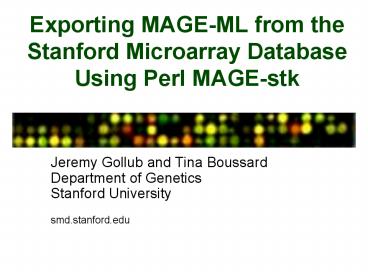Exporting MAGEML from the Stanford Microarray Database Using Perl MAGEstk - PowerPoint PPT Presentation
1 / 9
Title:
Exporting MAGEML from the Stanford Microarray Database Using Perl MAGEstk
Description:
Exporting MAGE-ML from the Stanford Microarray Database Using Perl MAGE-stk ... Generated by single method to ensure uniformity ... – PowerPoint PPT presentation
Number of Views:49
Avg rating:3.0/5.0
Title: Exporting MAGEML from the Stanford Microarray Database Using Perl MAGEstk
1
Exporting MAGE-ML from the Stanford Microarray
Database Using Perl MAGE-stk
- Jeremy Gollub and Tina Boussard
- Department of Genetics
- Stanford University
- smd.stanford.edu
2
Decomposing the problem
- Manageable chunks (Meta packages?)
- Experiment Meta Data
- Array Design Data
- Actual Data
- Mapping
- Relationships were hard-coded
- Close correspondences were easy (Person)
- Bad matches were problematic (FactorValues)
- Data fantasies were unavoidable (Protocols)
3
Problems with Software and Model
- Software/Model Source and targets
- Hybridization, for example
- sourceBioMaterialMeasurements
- physicalBioAssayTarget
- Documentation How to tell the XMLWriter that
your data files are external
- my w BioMAGEXMLWriter-gtnew
- (fh gt\STDOUT,
- external_data gt1,
- Tells writer data is external
- cube_holds_path gt1)
- Tells writer bioDataCube has the file path
- Usage Referencing other outside files
4
Instantiating and Writing Objects
- Abstract classes
- MAGE-stk should warn
- Independence/ownership
- Not all identifiable objects are independent
- Objects do not get written if their owner is not
present
5
Instantiating and Writing Objects
- Non-identifiable objects (e.g., Describable)
cannot live on their own - ExperimentDesign needs an Experiment object to
belong to. - The experiment Object has to be passed to the
MAGE object, not the ExperimentDesign Object - Create a blank Experiment object, and add the
ExperimentDesign, and pass the Experiment object
to the MAGE object.
6
Where to start Work Flow
- Paying attention to the intended use case
actually helped! - Additional workflows and use cases would be
appreciated.
7
General Approach
- Perl MAGE-stk
- Package and object-level exporter classes, as
appropriate - Print ? ArrayManufacture PhysicalArrayDesign
- User ? Person
- OntologyEntry exporter for CV objects
- SeqType ? biosequencetype OntologyEntry
- Utility module to export static objects
(SMDUtils.pm) - Channels
- QuantitationTypes
- Databases
- Generic method for generating identifiers
8
Identifiers
- Roughly adhere to LSID standard
- Generated by single method to ensure uniformity
- For machine parsing (name attribute is for human
readers) - Namespace identifier
- smd.stanford.edu for SMD objects
- Other for Database objects, as appropriate
- URNLSIDebi.ac.ukdatabaseEBI
- Object identifier
- Contains one or more SMD object attributes
- May contain non-database human information
- MAGE-OM object appended, to escape degeneracy
- Examples (URNLSIDsmd.stanford.edu)
- print.printid802/MAGE.PhysicalArrayDesign
- spotlist.printid_spotlist.spot802_17/MAGE.Feature
- print.printid_at.gene model802_At3g9247/MAGE.Comp
ositeSequence
9
Wisdom, Painfully Gained
- Memory usage is high remove limits.
- Performance is low report progress and dont
run over the web! (XMLWriter could usefully
become verbose) - Ontologies and best practices need some community
effort (but for now, were doing what EBI tells
us to do).































